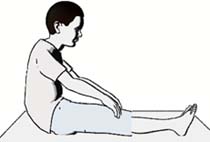Children on the autistic spectrum often have difficulties with posture, balance, coordination and motor planning. In fact recent studies show that movement difficulties are very common in children on the autistic spectrum, and importantly, poor motor skills are associated with greater difficulties with social communication.
Understanding why your child has motor difficulties is the first step to helping them improve their fitness, gross and fine motor skills. Once you have identified the possible reasons for your child's difficulties, you are better able to think about activities and exercises to improve their motor skills.
Difference in brain wiring
Learning a new motor skill depends on the brain's ability to form rich connections between the different parts of the brain involved in controlling movement, including the ability to use sensory information from the environment and from the body to predict what is going to happen next, to plan actions and adapt the actions as needed.
Typically developing children make these brain connections, and learn new motor tasks, easily in the course of everyday experience. They are motivated to take on new challenges, explore different ways of achieving their goals and expect to master new skills with repeated practice. This gives them a sense of self-efficacy and I-can-do.
Children with autism, and those with developmental coordination disorder, do not learn new motor skills in the same easy way, possibly because of differences in the way their brains form new connections.
How differences in brain wiring affect motor skills
Motor skill performance and learning depend on forming rich connections between different parts of the brain that link:
- sensory information from the body – skin, joints, muscles, vestibular system
- sensory information from the environment: vision and hearing
- intentions, goals and feelings
This information is used for predicting what will happen next, planning movements to achieve goals, executing the movements and evaluating the outcome: was I successful, did I achieve my goal, what needs to be changed to improve?
Because of the differences in how the brain is wired, children with autism do not easily integrate all the information needed for task learning, may use different pathways which are less efficient and may need extra practice and guidance to learn new motor skills.
However, given the right opportunities all children with autism can improve their motor skills: it just takes time, patience and know how.
Read more:
Jason learns to catch a ball - a teaching session
Task based training for autism and DCD
Movement difficulties related to anxiety and attention issues
Good motor control is learned through experience. Typically developing children spend a lot of time working on learning and improving motor skills as part of their everyday activities. They explore different ways to achieve a goal, persist in the face of failure and learn from their mistakes. Through lots of repeated experience young children learn how to use sensory information to plan and adapt their actions to achieve their goals.
Autistic children are not as good at exploring different ways to achieve a goal, have difficulty sorting through and selecting the right sensory information for a task and are not as good at learning through experience.
Movement difficulties caused by joint hypermobility
Although there is no research that has looked at the prevalence of generalized joint hypermobility (GJH) in autistic children, anecdotal evidence suggests that it is a fairly common feature.
GJH simply means that the child has joints that are more flexible than usual. This happens when the connective tissue which makes up the joint structures (capsule and ligaments) is more compliant (more easily stretched) than usual. Muscles are also affected, with a tendency to weakness (sometime mistakenly called low muscle tone).
Hypermobile joints are less stable than usual; this means that the child needs stronger muscles to support the body. Fortunately strength training will improve both joint stability and muscle strength.
The increased compliance (give) in the connective tissue also affects the blood vessels and internal organs which can lead to low blood pressure, trouble with bladder control and voiding, and constipation.
Interestingly, children with joint hypermobility tend to have a fearful/anxious temperament which affects their behaviour.
    |
How joint hypermobility affects motor function
Joint hypermobility affects the development of motor control in several ways. Because the joints inherently less stable, more muscle work is needed for good posture and movement control. Children with joint hypermobility often have difficulty sitting erect for working at a table, hypermobile finger joint affect pencil grip for drawing and handwriting, leg weakness affects walking distances, running speed, managing stairs, climbing on the climbing frame and hanging from monkey bars.
Loose joint, some tight muscles
 In addition children with GJH often have some tight muscles in the hips and shoulders. This affects sitting comfortably on a chair or cross legged on the floor, as well as shoulder movements needed for drawing and handwriting.
In addition children with GJH often have some tight muscles in the hips and shoulders. This affects sitting comfortably on a chair or cross legged on the floor, as well as shoulder movements needed for drawing and handwriting.
- Strength, flexibility and general fitness training all help children with hypermobile joints to get better at everyday activities such as sitting for working at a table, shoulder control for handwriting, going up and down stairs, walking distances, running speed and fitness, enjoying climbing frames and monkey bars.
Night pain and joint hypermobility
Children with joint hypermobility and tightness in the hip muscles often experience pain in the legs following exercise, or when they are going through a growth spurt. Children with autism often have an increased tendency to respond negatively to discomfort, which can make night pain related to exercise very bothersome. Read more about night pain in hypermobility
- Fitness training that includes stretching and strengthening goes along way to improving pain following exercise. Some gentle stretching before going to sleep at night also helps to alleviate knee pain that occurs during growth spurts.
 Toe walking and hypermobility
Toe walking and hypermobility
Toe walking is associated with tightness in the calf muscles as well as the muscles crossing over the back and sides of the hips and legs. In most cases children who walk on the toes have hypermobile joints. (Some tight muscles is a common feature of joint hypermobility).
The toe walking is probably more related to muscle tightness along with poor motor planning , rather than be a sensory issue. Children who walk on their toes often have tightness in the muscles crossing the sides of their hips. They stand with their legs wide apart and the feet turned out. This tightness makes it uncomfortable to stand with the feet close together and the heels flat on the floor, or to walk with the heels flat on the floor.
Depending on how tight the calf muscles are, a program of stretching exercises that target the hip muscles in particular, along with foot balance training will improve toe walking.
Read more: Idiopathic toe walking in children and Idiopathic toe walking: for therapists
Low muscle tone
The problem with the term "low muscle tone" is that it is a bit of a catch-all idea. It seems to mean different things to different people. Mostly it is a box into which any movement difficulty can be thrown without really pin-pointing what the underlying causes of the child' difficulties are.
In many cases the underlying reason for the appearance of low muscle tone can be attributed to joint hypermobility. The distinction is important because it affects the choice of remedial activities. Movement difficulties caused by joint hypermobility are improved by exercises that improve strength and general fitness.
Read more: My child has been diagnosed with low muscle tone. What does this mean?
Bibliography
Mohd Nordin A, Ismail J, Kamal Nor N. Motor Development in Children With Autism Spectrum Disorder. Front Pediatr. 2021 Sep 15;9:598276.
SfA Fitness and Coordination Training Guide

All the information you need to be your child's coach and advocate
$20 for a subscription
Disclaimer The content on this site is provided for general information purposes only and does not constitute professional advice. All liability is excluded to the fullest extent permitted by law in respect of any loss or damage whether direct, indirect or consequential that arises in connection with the use of or reliance upon any content forming part of this site.
|
Joan, mother of 8 year old autistic Zak Your website is the only site I have found that has answered all my questions and provided practical solutions for my son's challenges with posture, muscle strength, hand writing and muscle tone. I am really looking forward to starting the handwriting work with him as I have known for ages that it was linked to muscular strength/flexibility problem but did not have the tools to work on it. Previous occupational therapy made differences in other areas but not that one. Now I can test him and have the tools to help him. Brilliant. |


